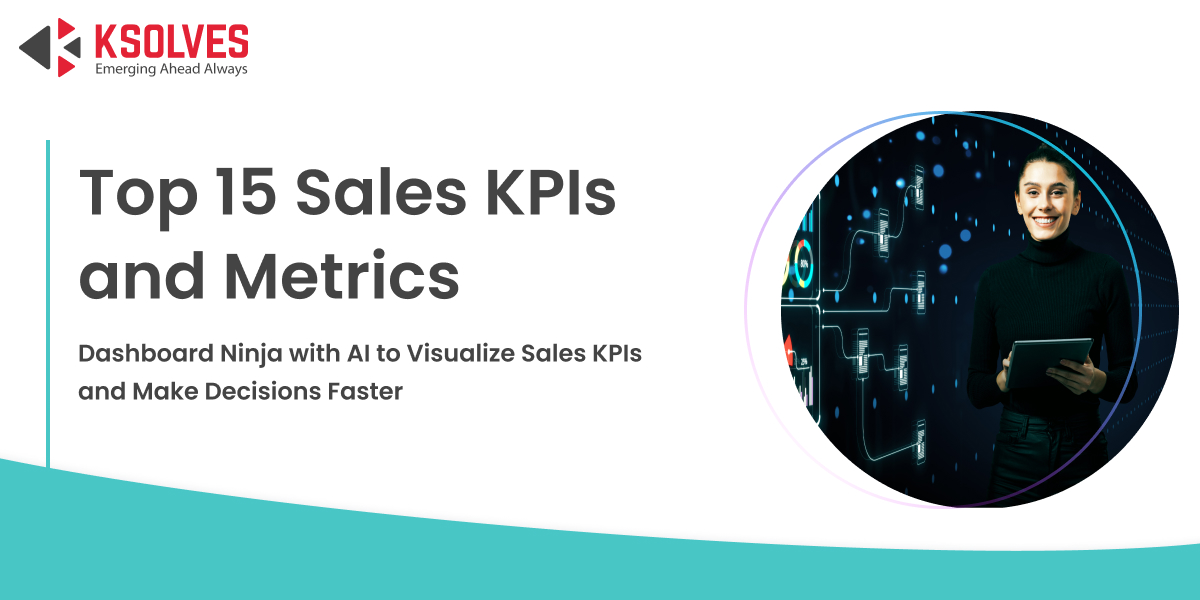Top 15 Sales KPIs for Sales Teams to Track in 2025
Odoo
5 MIN READ
January 30, 2025
![]()

Data is the foundation of everything the sales teams do. Whether they want to grow their sales, assess performance, or make strategic decisions, they leverage data from systems like CRMs, ERPs, and others. As data is generated in sheer volumes, it becomes essential for sales teams to analyze it and extract meaningful insights. For this, they rely on measuring sales key performance indicators (KPIs).
Sales key performance indicators help sales teams track their progress toward business goals. Also, they provide a clear visibility into the entire sales team’s performance.
However, it becomes daunting to interpret insights present in the text format. As a result, businesses tend to adopt dashboard solutions that visualize insights, helping them interpret data quickly and make decisions faster.
Isn’t it amazing if the sales teams get visualized insights right within their ERP? If you use Odoo as an ERP, Dashboard Ninja with AI is the ultimate Odoo dashboard solution. It lets you create custom dashboards with just a few clicks, allowing you to add the required sales KPIs to the dashboard and analyze them easily.
Let’s explore some of the best sales KPIs that every sales team should track to measure their performance and success.
What are Sales KPIs?
Sales Key Performance Indicators (KPIs) are quantifiable metrics that evaluate how effectively a sales team achieves its predetermined goals. These metrics cover every aspect of the sales funnel, from lead generation and conversion rates to customer retention and revenue growth. Sales KPIs aren’t just numbers; they are instrumental in improving sales team performance, boost sales revenue, and optimize the sales cycle.
Why Do Sales Teams Track Sales KPIs?
Let’s shed light on some of the major reasons why sales teams track KPIs.
- A Clear Overview of Sales Performance
Tracking KPIs gives the sales team a clear, real-time snapshot of their performance. It helps managers and reps see how well they’re progressing against set goals, whether it’s revenue targets, lead conversion rates, or quota attainment.
With this clear overview, teams can quickly identify if they are on track or if adjustments are needed.
- Determine the Sales Team’s Strengths & Weaknesses
By tracking individual and team KPIs, sales managers can assess which reps are excelling in specific areas (e.g., closing deals) and which need support (e.g., lead generation).
This helps in providing targeted coaching, resources, or training, enabling the team to improve collectively.
- Drive Data-Driven Decision-Making
KPIs provide measurable, factual data that drives decision-making. Sales leaders can use this data to make informed decisions about where to focus efforts, whether it’s adjusting sales strategies or reallocating resources.
Data-driven decisions eliminate guesswork, optimize resource usage, and increase the chances of hitting sales targets.
- Improve Sales Strategies
Tracking KPIs reveals trends, patterns, and insights into sales activities. This information can be used to refine strategies, such as adjusting the sales funnel, improving messaging, or reallocating focus on high-converting lead sources.
This continuous optimization leads to higher sales conversion rates, shorter sales cycles, and overall better performance.
- Enhance Customer Relationships
KPIs like customer satisfaction, retention rates, and Net Promoter Score (NPS) help sales teams assess how well they’re nurturing customer relationships. Understanding these metrics ensures that the team is not just closing deals but also maintaining long-term, fruitful relationships.
Stronger customer relationships lead to repeat business, referrals, and improved customer loyalty, which contributes to sustainable sales growth.
15 Best Sales KPIs to Track for Every Sales Team
1. Monthly Sales Growth
Monthly Sales Growth measures the change in sales revenue from one month to the next. It provides insights into the effectiveness of sales strategies and market conditions. A positive growth rate indicates a healthy sales trend, while negative growth signals the need for adjustments.
| Formula:
Monthly Sales Growth (%) = [(Current Month’s Sales – Previous Month’s Sales) / Previous Month’s Sales] × 100 |
This KPI is essential for understanding your revenue trajectory and can help track whether marketing campaigns or product strategies are working.
2. Average Profit Margin
Average Profit Margin indicates how much profit is generated from sales after accounting for costs. A higher profit margin shows that the business is keeping costs low while maintaining good pricing strategies. It’s crucial for assessing financial health and operational efficiency.
| Formula:
Average Profit Margin (%) = [(Revenue – Total Costs) / Revenue] × 100 |
This metric helps businesses set profitable pricing models and control production or service costs more effectively.
3. Customer Acquisition Cost (CAC)
CAC measures how much it costs to acquire a new customer, including marketing, sales efforts, and related expenses. A lower CAC means that your sales and marketing strategies are efficient, while a high CAC could signal that the cost to acquire customers is unsustainable.
| Formula:
Customer Acquisition Cost = Total Sales & Marketing Cost / Number of New Customers |
Tracking this KPI ensures that the company isn’t overspending on customer acquisition and can maintain a healthy profit margin.
4. Average Customer Lifetime Value (CLV)
CLV estimates the total revenue a customer will generate for a business throughout their relationship. A higher CLV indicates that customers stay loyal for longer periods, bringing in more revenue over time. This metric helps businesses prioritize long-term customer relationships.
| Formula:
CLV = Average Purchase Value × Purchase Frequency × Customer Lifespan |
CLV is vital for understanding how much to invest in acquiring and retaining customers while ensuring profitable growth.
5. Monthly Sales Booking
Monthly Sales Booking measures the total value of contracts or deals closed during a specific month. This KPI is a direct indicator of revenue inflow and helps measure whether sales goals are being met.
| Formula:
Monthly Sales Booking = ∑(Value of Closed Deals in the Month) |
By tracking monthly bookings, businesses can forecast cash flow and evaluate whether their sales team is on target.
6. Average Purchase Value
Average Purchase Value calculates the average amount spent by customers per purchase, providing insights into customer buying behavior. It’s useful for understanding whether customers are purchasing more expensive products or opting for higher quantities.
| Formula:
Average Purchase Value = Total Revenue / Number of Purchases
|
By increasing this value, businesses can focus on upselling or cross-selling strategies to drive higher revenue per customer.
7. Lead Conversion Rate
The Lead Conversion Rate measures how many of your leads are turning into actual paying customers. A higher conversion rate indicates that your sales team is effective at nurturing and closing deals.
| Formula:
Lead Conversion Rate (%) = (Number of Leads Converted / Total Leads) × 100 |
Monitoring this KPI helps improve sales strategies and optimize the lead qualification process to focus on high-potential leads.
8. Customer Retention Rate
This metric shows the percentage of customers who continue to buy from your business over a specific period. High retention rates suggest customer satisfaction and loyalty, which are crucial for sustainable long-term growth.
| Formula:
Retention Rate (%) = [(Total Customers at End of Period – New Customers Acquired) / Total Customers at Start of Period ] × 100 |
It’s an important KPI for businesses that rely on repeat customers, such as subscription-based models.
9. Sales Opportunities
Sales Opportunities measure the number of potential deals or prospects in the sales pipeline. A strong flow of opportunities indicates a healthy sales pipeline, which is essential for ensuring consistent sales revenue.
| Formula:
Sales Opportunity = Value of Sale x Opportunity Status |
This KPI helps sales teams gauge how many potential deals are being pursued and the likelihood of closing new business.
10. Monthly Calls Per Sales Rep
This KPI tracks the number of calls made by each sales rep within a month. It’s a measure of activity, showing how proactive the team is in engaging with leads and moving deals forward.
| Formula:
Monthly Calls Per Rep = Total Sales Calls in a Month / Number of Sales Reps |
When correlated with conversion rates, this metric can reveal the optimal number of calls required for closing deals.
11. Average Sales Cycle Length
The Sales Cycle Length measures the average time it takes from initial contact with a lead to closing a deal. Shorter cycles typically indicate a more efficient sales process, whereas longer cycles may point to inefficiencies or objections that need to be addressed.
| Formula:
Average Sales Cycle Length = Sum of Sales Cycle Durations / Number of Closed Deals |
A shorter cycle is usually a sign of a streamlined sales process, so businesses should aim to reduce this metric over time.
12. Lead-to-Sale Percentage
This metric shows the percentage of leads that convert into actual sales. It’s a valuable KPI for evaluating how well leads are being qualified and handled throughout the sales funnel.
| Formula:
Lead-to-Sale (%) = (Total Sales / Total Leads) × 100 |
A higher lead-to-sale percentage indicates that your sales efforts are highly effective and that your lead qualification process is working well.
13. Average Conversion Time
This metric calculates the average amount of time it takes for a lead to convert into a customer. It’s useful for understanding how efficient your sales process is and where delays may occur.
| Formula:
Average Conversion Time = Total Time to Convert All Leads / Total Converted Leads |
Reducing conversion time can directly increase the efficiency of the sales team, leading to faster revenue generation.
14. Monthly Recurring Revenue (MRR)
MRR measures the predictable revenue generated each month from subscription-based customers or recurring deals. This is particularly relevant for businesses that rely on subscriptions, providing visibility into stable, recurring revenue streams.
| Formula:
MRR = Total Monthly Revenue from Recurring Customers |
Tracking MRR helps businesses forecast future revenue and make informed decisions about investments and growth strategies.
15. Annual Recurring Revenue (ARR)
ARR is similar to MRR but calculates recurring revenue on an annual basis. It’s helpful for businesses with long-term subscription models, such as SaaS companies, and provides a clearer picture of yearly revenue trends.
| Formula:
ARR = MRR × 12 |
This metric is vital for long-term planning and is often used by investors to gauge the stability of a company’s revenue.
Dashboard Ninja with AI to Visualize Sales KPIs
Now you know what are the top sales KPIs you should track to measure the effectiveness of your sales team’s effort. It’s time to learn about Dashboard Ninja with AI that will help you visualize these sales KPIs in a single dashboard. This helps you analyze and monitor all critical sales metrics quickly and make smarter business decisions.
Dashboard Ninja with AI is the ultimate Odoo dashboard tool that lets you create reporting dashboards with just a few clicks. With its drag-and-drop interface, you can create custom dashboards, highlighting the required sales KPIs. Unlike Odoo, it does not require technical expertise to create custom dashboards. With 17 different types of visualizations, the app represents your sales KPIs in an easily understandable layout.
What’s more interesting is Dashboard Ninja with AI provides you with the flexibility to generate chart explanations. This way, you can have a clear understanding of data points and their correlations of a specific dashboard item (chart).
Conclusion
This was all about the top Sales KPIs and utilizing Dashboard Ninja with AI to visualize them. With the help of above sales KPIs, your sales team can identify the areas of improvement, know what works and what not, and drive better performance. Each sales KPI mentioned above provides insights into specific aspects of sales operations. This helps you make data-driven decisions for your business that lead to growth.
Moreover, utilizing Dashboard Ninja with AI boosts your productivity by reducing the time spent on analyzing and interpreting raw data. With customizable dashboards, you can highlight any KPIs you wish to and accelerate decision-making. Try Dashboard Ninja with AI and see the difference. Buy Now.
![]()






AUTHOR
Odoo
Neha Negi, Presales and Business Associate Head at Ksolves is a results-driven ERP consultant with over 8 years of expertise in designing and implementing tailored ERP solutions. She has a proven track record of leading successful projects from concept to completion, driving organizational efficiency and success.
Share with